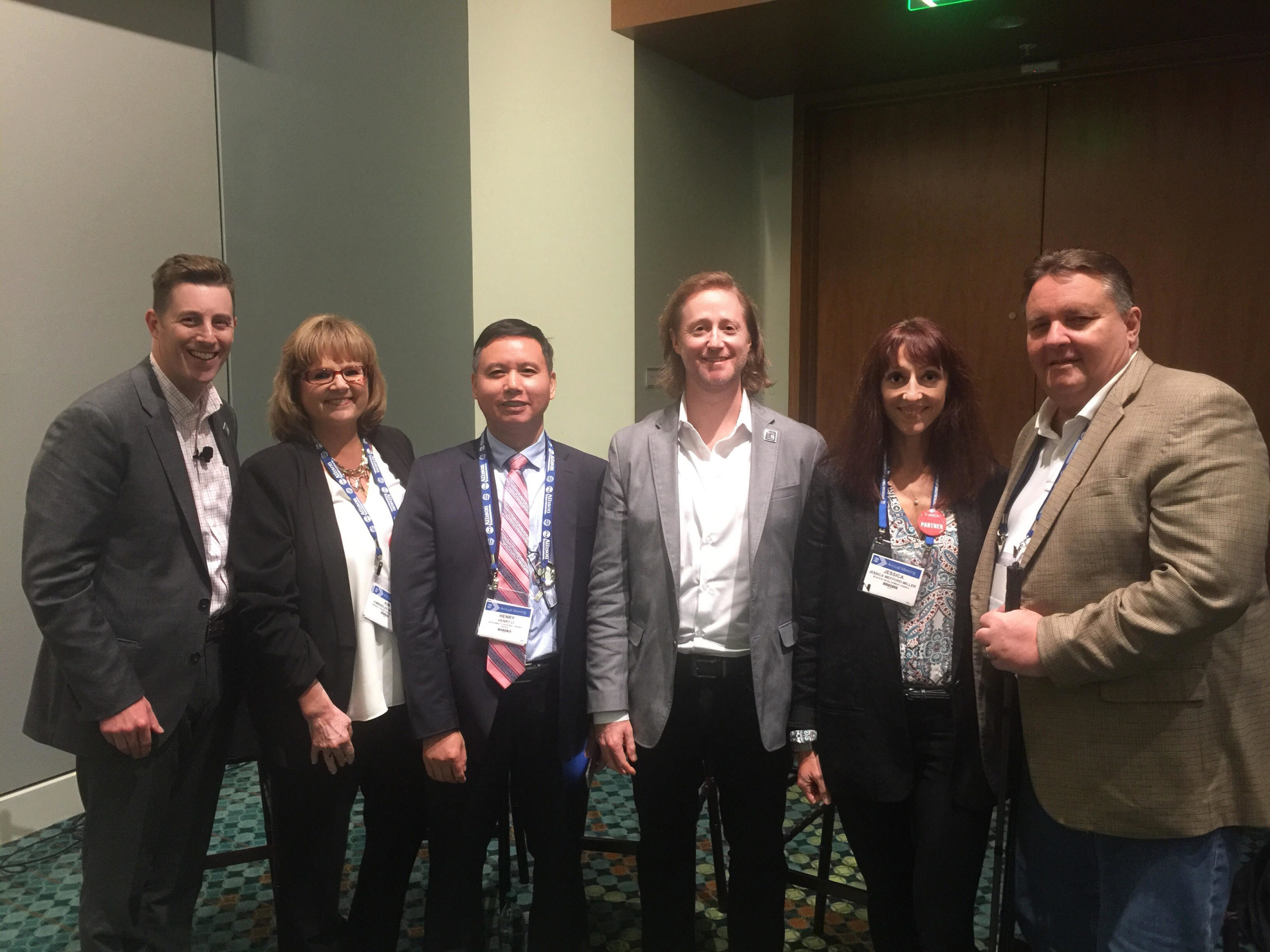
TransLoc hosted a conversation about agency-owned microtransit at the APTA 2018 Annual Meeting in Nashville, Tennessee with (left to right) Josh Cohen, TransLoc National Director of Policy; Kimberlee Morton, CEO of Norwalk Transit District; Henry Li, CEO of Sacramento Regional Transit District;Doug Kaufman, CEO of TransLoc; Jessica Mefford-Miller, Executive Director of St. Louis Metro Transit; and Robbie Makinen, CEO of Kansas City Area Transportation Authority.
With declining ridership from the continued reliance on cars and a growing popularity of TNCs, like Uber and Lyft, it’s no surprise that a popular theme coming away from American Public Transportation Association’s (APTA) annual meeting is the need to rethink how public transit can evolve with new modes and specifically examining the role microtransit has in the greater system of public transit.
As a part of the conference, the “Reimagining Public Transit with Microtransit” panel discussion hosted by TransLoc National Director of Policy Josh Cohen explored this topic in depth. Panelists included CEO of Sacramento Regional Transit District Henry Li, Executive Director of St. Louis Metro Transit Jessica Mefford-Miller, CEO of Norwalk Transit District Kimberlee Morton, and CEO of Kansas City Area Transportation Authority Robbie Makinen.
The conversation covered a lot of ground with insights shared directly from each agency’s experience and openness around the specific challenges they are tackling.
The shifting role of transit with new goals
“Transit has a new face now, and it’s changing, it’s evolving. It’s going to change and you’re either going to be on the wagon, or you’re going to be left behind seeing what’s going to happen. Because it’s not going to stay the same.” – Kimberlee Morton, Norwalk Transit District
“Ridership is fairly straight forward. But then some of the intangibles – public perception, that’s intangible, but it matters. The customer experience and how that impacts their life outside of their transit trip – that matters too. We won’t measure that, but again that’s a goal.” – Jessica Mefford-Miller, St. Louis Metro Transit
Achieving public agency efficiency with private sector principles and partners
“You need to have a strong team to implement [microtransit]. That requires your processes to be streamlined so that you can get things down very quickly. One of our principles in [our agency] is business optimization. We need to run our business like a true private enterprise, not like one of the bureaucratic organizations.” – Henry Li, Sacramento Regional Transit District
“There’s room in the tent for everybody. If you do not start getting with the private sector, you’re just going to embrace and stay with public transit for the last 20 years. Or, do you want to build something for the next 20 years? These private sector companies coming in to fill your gaps are exactly what you need.” – Robbie Makinen, Kansas City Area Transportation Authority
“[Success] is being able to increase the intensity of service while still providing accessibility across our systems. So it’s increasing the number of opportunities we can provide while keeping our operating costs constant, and that is huge.” – Jessica Mefford-Miller, St. Louis Metro Transit
“Yes, we’re public agencies, but I really believe we have to stop running our businesses like they’re public subsidized agency and more like private businesses. There’s stuff that we’re doing out there that’s costing taxpayers tons of money, so let’s get out there and do what the privates do.” – Kimberlee Morton, Norwalk Transit District
Community and economic development
“(Microtransit) might take a commute down from two buses and a train to just two vehicles. And if you can cut off 30 minutes of someone’s commute time and give them an hour back each day, that makes a huge impact on the quality of life which, in turn, contributes to further economic development. At the end of the day, it’s all about customers and improving their experiences, which achieves greater results for the region.” – Jessica Mefford-Miller, St. Louis Metro Transit
“We started looking at what was happening to the population, and the population growth we were seeing was 25-44 and it was definitely the millennial generation, and you look at that population and it’s 37% of our community. We said we’ve got to do something different.” – Kimberlee Morton, Norwalk Transit District
Accessibility is achieved with foresight
“You can get an on-demand ride just like anybody else. And the fun part about that is that we designed it with the cornerstone of our folks with diverse abilities first… You don’t chase that shiny thing and then reverse engineer things, and think ‘Oh, what about those people?’” – Robbie Makinen, Kansas City Area Transportation Authority
Taking risks to see results
“We needed to find out how we can win the support of the citizens of that area, especially the elected officials. We started with one district… We threw about 10 [microtransit] vehicles into that city. Now our daily ridership jumped from 30 to 300. Because of the successful story in that city alone, those elected official representing other underserved areas, they started to scream ‘We need to be servicing our areas, too.’ In six months, our funding agency gave us about $18m.” – Henry Li, Sacramento Regional Transit District
“Change comes at the end of your comfort zone. But that’s where success is, and that’s where innovation lies. It’s okay to fail. It’s okay to end up in the newspaper or on a blog or whatever for a little bit. It’s okay because if you keep working that way you’re going to find an answer.” – Robbie Makinen, Kansas City Area Transportation Authority